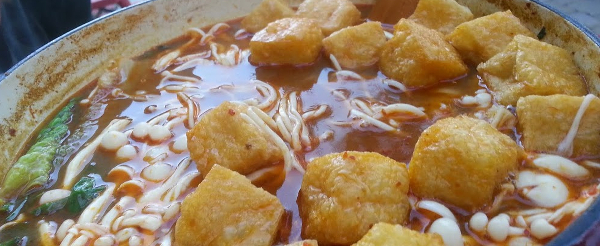
Chongqing Hot Pot is a great party dish to share with friends. We give you the low down on all the variations and styles. It looks like a soup, but it is not eaten like one. Everything is dipped in a sour and savory sauce before consuming.
Chongqing is a major city in southwest China. Administratively, it is one of China's four direct-controlled municipalities (the other three are Beijing, Shanghai and Tianjin), and is the only such municipality in inland China. The Yangtze and Jialing rivers flow through the city making it a busy trade entrepot. In days gone by, the city had many many ports and docks.
Chaotian Men (meaning "a door at the top of the sky") port was and is the busiest port in Chongqing. It is located where the Yangtze and Jialing rivers meet. Historically, there were many slaughterhouses operated by the Hui people, who lived there. The Hui people are one of the 56 officially recognized minorities in China. Hui don't generally eat organ meats or sweetbreads, so these parts were often simply discarded. Poorer boatmen and sailors, who couldn't afford fresh meat from the market, collected the discarded meats and cooked them in a big pot of water spiced with chilies making the first Chongqing hot pot. It is now a dish (and style of eating) that is enjoyed by people of all socio-economic levels and ethnic origins throughout China.
>There are at least 5 main varieties of hot pot in China.
Traditional Beijing hot pot known as Shuàn yáng ròu (instant-boiled lamb), a fragrant, mild broth is made in a large brass pot heated by burning charcoal set inside a central chimney. Nowadays it is more common to use a gas burner instead of charcoal.
Another variation is Chongqing má là (Chongqing numb and spicy) hot pot, to which Sichuan pepper (known here as prickly ash) is used. Combined with spicy ingredients like chili, it creates a sensation on the tongue that is both spicy hot and mouth numbing. In order to help diners find the meat and vegetables they want to eat next, a multi-sectioned frame is placed in the cooking pot and only one type of ingredient is cooked in each section. To say that the residents of Chongqing are fond of their hot pot would be an understatement. Every year, they host a hot pot festival in which tens of thousands of people participate. In addition to nearly one thousand regular hot pots in this festival, there is a giant hot pot that is 30 feet in diameter and three feet tall holding almost 3 tons of hot pot!
Normally, Chongqing hot pot seasoning is spicy, while in the Beijing variety, the soup is much milder. The dipping sauces differ as well. In the south, people prefer sesame oil and black vinegar whereas in the north, especially in Beijing, simple sesame paste is favored.
In Yunnan, in southwest China, spicy seasoning is popular but wild ingredients and vegetarian ingredients figure more prominently, particularly mushrooms. This type of hot pot is called Jùn gu (means fungi and mushrooms) hot pot or Jùn gu stew. In this kind of hot pot, people rarely use meat.
Manchurian hot pot uses plenty of Suan cai (Chinese sauerkraut) to make the pot's stew sour. Thinly sliced pork is a main ingredient in this variation.
Lastly, a Cantonese variation includes mixing a raw egg with the condiments which is thought to reduce the amount of 'heat' absorbed by the food, thereby reducing the likelihood of a sore throat according to Chinese herbalist theories. Yet another variant includes the use of rice congee (rice porridge) instead of stock. Cantonese hot pot also uses more sea food, such as fish balls and geoduck clams.
Besides these 5 main variations, many other emerging styles of hot pot can be found throughout mainland China, such as fish head hot pot, goose feet hot pot, and rabbit hot pot.
Hot pot tastes different from restaurant to restaurant because there is no established essentials for seasoning a hot pot or ingredients that are cooked or the sauces used. Each restaurant concocts their own hot pot seasoning and these are often considered to be "trade secrets."
Chinese hot pot is always cooked at the dinner table. There really is no other practical way to cook it. It is cooked either in a "steamboat" (with a central chimney like in Beijing style) or a very large pot. Actually the chimney style hot pots that are locally available are too small to use if you have more than a couple of diners, so pull out the large pot if you have a party! You can use an induction heater with an iron pot (safest by far), a portable electric or gas stove, or an electric pot.
Ingredients:
Please note: Giving exact amounts of individual ingredients for this dish is not very helpful because you must adjust the amounts to the number of diners and also according to what ingredients are available and what diner's prefer. Chinese often use organ meats when they cook hot pot
Ingredient suggestions
- Meat - thinly sliced pork, beef, lamb and or chicken
- Seafood - shrimp, squid, octopus
- Quail eggs (available in cans)
- Seafood balls (these come in quite a variety)
- Fried tofu
- Vegetables - leafy greens, mushrooms, squash, winter melon, bean sprouts etc.Root vegetables (all in quarter inch slices)
- potatoes, taro, shanyao (or
- Japanese nagaimo)
- Noodles (your choice)
- Chinese hot pot seasoning (Chongqing is the hottest, Sichuan is a bit milder. Little Sheep hot pot seasoning comes in mild and spicy versions.)
Dipping Sauce:
- garlic (to taste)
- Chinese black vinegar
- Chinese sesame oil (or substitute Japanese sesame oil)
Preparation:
Prepare Dipping Sauce:
- Peel and crush several cloves of garlic (more or less to taste).
- Put about 1/8 of a cup of black vinegar and the same amount of sesame oil in each diner's bowl.
- Add crushed garlic to each bowl.
Prepare Hot Pot:
- Slice meat and vegetables into thin slices, and set aside on individual plates.
- Fill 2/3 of the hot pot with water and stir in seasoning mix.
- Bring hot pot to a boil.
- Add a portion of each hot pot ingredient to the pot (not everything at once!). Note: different ingredients require different cooking times. Test doneness! Also be careful not to overcook the shanyao as it will become mushy and break apart. Warning: The yolks of quail eggs remain liquid even after they are fully cooked. As such when you bite into one, the yolk might stick to the roof of your mouth and burn you. Please be careful, if necessary let the eggs cool for a few minutes in your bowl!
- As each ingredient reaches doneness, each diner can take from the hot pot what they want. Lightly dip the cooked ingredients in the dipping sauce and enjoy!
Recipe by Xuedi (aka "Gina") Yuan
Photos by Kim Douwes








